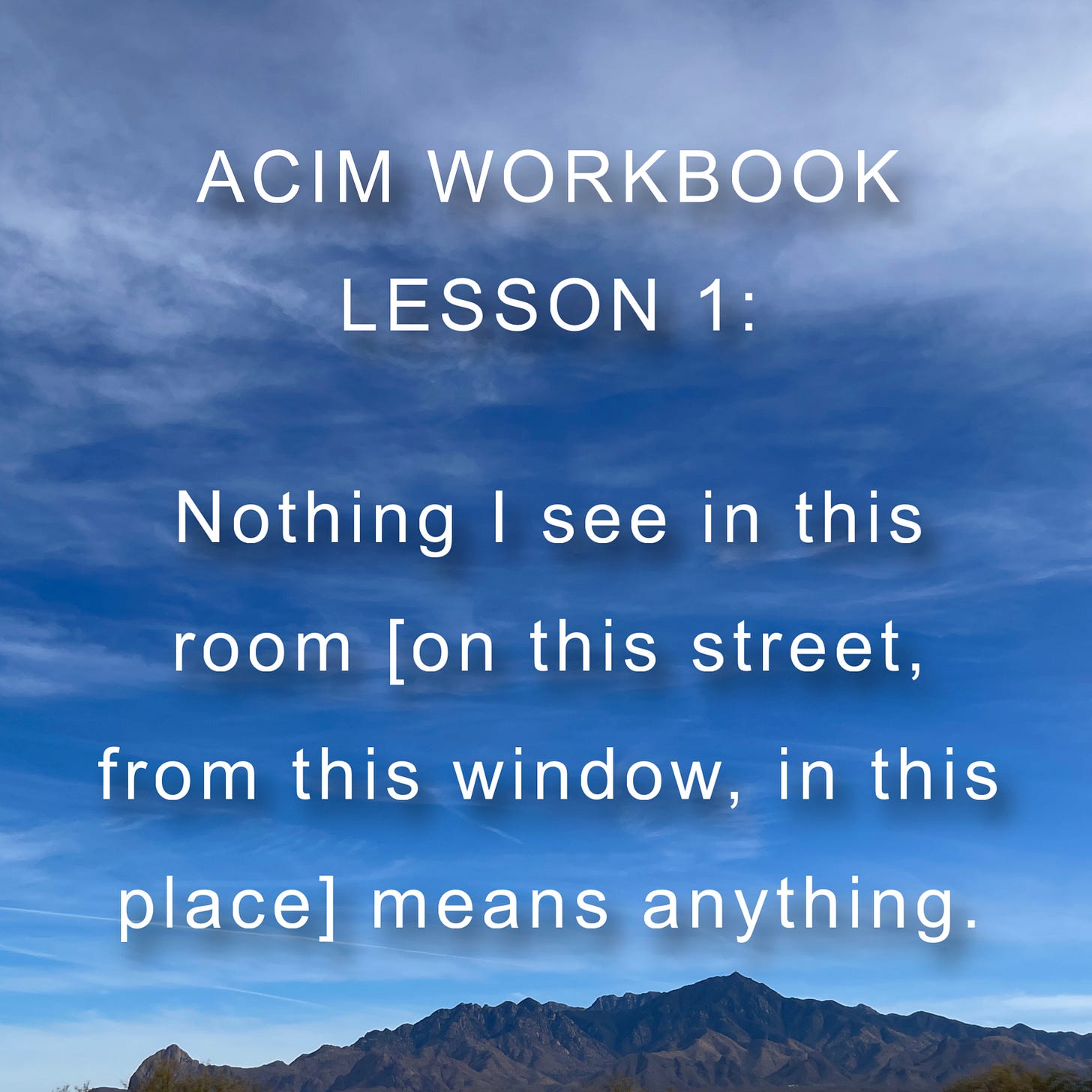Workbook for Students
Introduction
1. A theoretical foundation such as the text provides is necessary as a framework to make the exercises in this workbook meaningful. ²Yet it is doing the exercises that will make the goal of the course possible. ³An untrained mind can accomplish nothing. ⁴It is the purpose of this workbook to train your mind to think along the lines the text sets forth.
2. The exercises are very simple. ²They do not require a great deal of time, and it does not matter where you do them. ³They need no preparation. ⁴The training period is one year. ⁵The exercises are numbered from 1 to 365. ⁶Do not undertake to do more than one set of exercises a day.
3. The workbook is divided into two main sections, the first dealing with the undoing of the way you see now, and the second with the acquisition of true perception. ²With the exception of the review periods, each day’s exercises are planned around one central idea, which is stated first. ³This is followed by a description of the specific procedures by which the idea for the day is to be applied.
4. The purpose of the workbook is to train your mind in a systematic way to a different perception of everyone and everything in the world. ²The exercises are planned to help you generalize the lessons, so that you will understand that each of them is equally applicable to everyone and everything you see.
5. Transfer of training in true perception does not proceed as does transfer of the training of the world. ²If true perception has been achieved in connection with any person, situation or event, total transfer to everyone and everything is certain. ³On the other hand, one exception held apart from true perception makes its accomplishments anywhere impossible.
6. The only general rules to be observed throughout, then, are: First, that the exercises be practiced with great specificity, as will be indicated. ²This will help you to generalize the ideas involved to every situation in which you find yourself, and to everyone and everything in it. ³Second, be sure that you do not decide for yourself that there are some people, situations or things to which the ideas are inapplicable. ⁴This will interfere with transfer of training. ⁵The very nature of true perception is that it has no limits. ⁶It is the opposite of the way you see now.
7. The overall aim of the exercises is to increase your ability to extend the ideas you will be practicing to include everything. ²This will require no effort on your part. ³The exercises themselves meet the conditions necessary for this kind of transfer.
8. Some of the ideas the workbook presents you will find hard to believe, and others may seem to be quite startling. ²This does not matter. ³You are merely asked to apply the ideas as you are directed to do. ⁴You are not asked to judge them at all. ⁵You are asked only to use them. ⁶It is their use that will give them meaning to you, and will show you that they are true.
9. Remember only this; you need not believe the ideas, you need not accept them, and you need not even welcome them. ²Some of them you may actively resist. ³None of this will matter, or decrease their efficacy. ⁴But do not allow yourself to make exceptions in applying the ideas the workbook contains, and whatever your reactions to the ideas may be, use them. ⁵Nothing more than that is required.
Part I
Lesson 1
Nothing I see in this room [on this street, from this window, in this place] means anything.
1. Now look slowly around you, and practice applying this idea very specifically to whatever you see:
²This table does not mean anything.
³This chair does not mean anything.
⁴This hand does not mean anything.
⁵This foot does not mean anything.
⁶This pen does not mean anything.
2. Then look farther away from your immediate area, and apply the idea to a wider range:
²That door does not mean anything.
³That body does not mean anything.
⁴That lamp does not mean anything.
⁵That sign does not mean anything.
⁶That shadow does not mean anything.
3. Notice that these statements are not arranged in any order, and make no allowance for differences in the kinds of things to which they are applied. ²That is the purpose of the exercise. ³The statement should merely be applied to anything you see. ⁴As you practice the idea for the day, use it totally indiscriminately. ⁵Do not attempt to apply it to everything you see, for these exercises should not become ritualistic. ⁶Only be sure that nothing you see is specifically excluded. ⁷One thing is like another as far as the application of the idea is concerned.
4. Each of the first three lessons should not be done more than twice a day each, preferably morning and evening. ²Nor should they be attempted for more than a minute or so, unless that entails a sense of hurry. ³A comfortable sense of leisure is essential.




